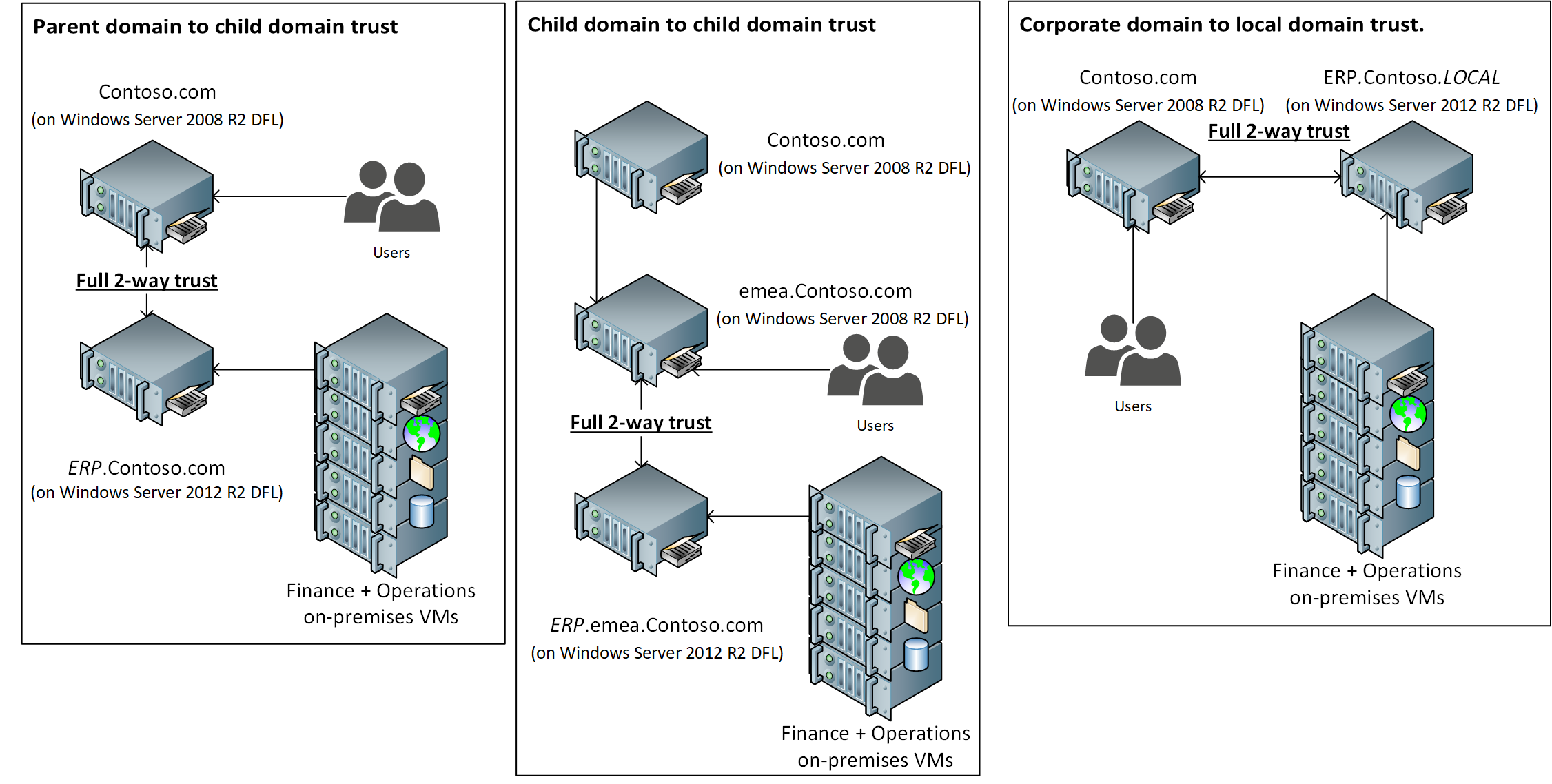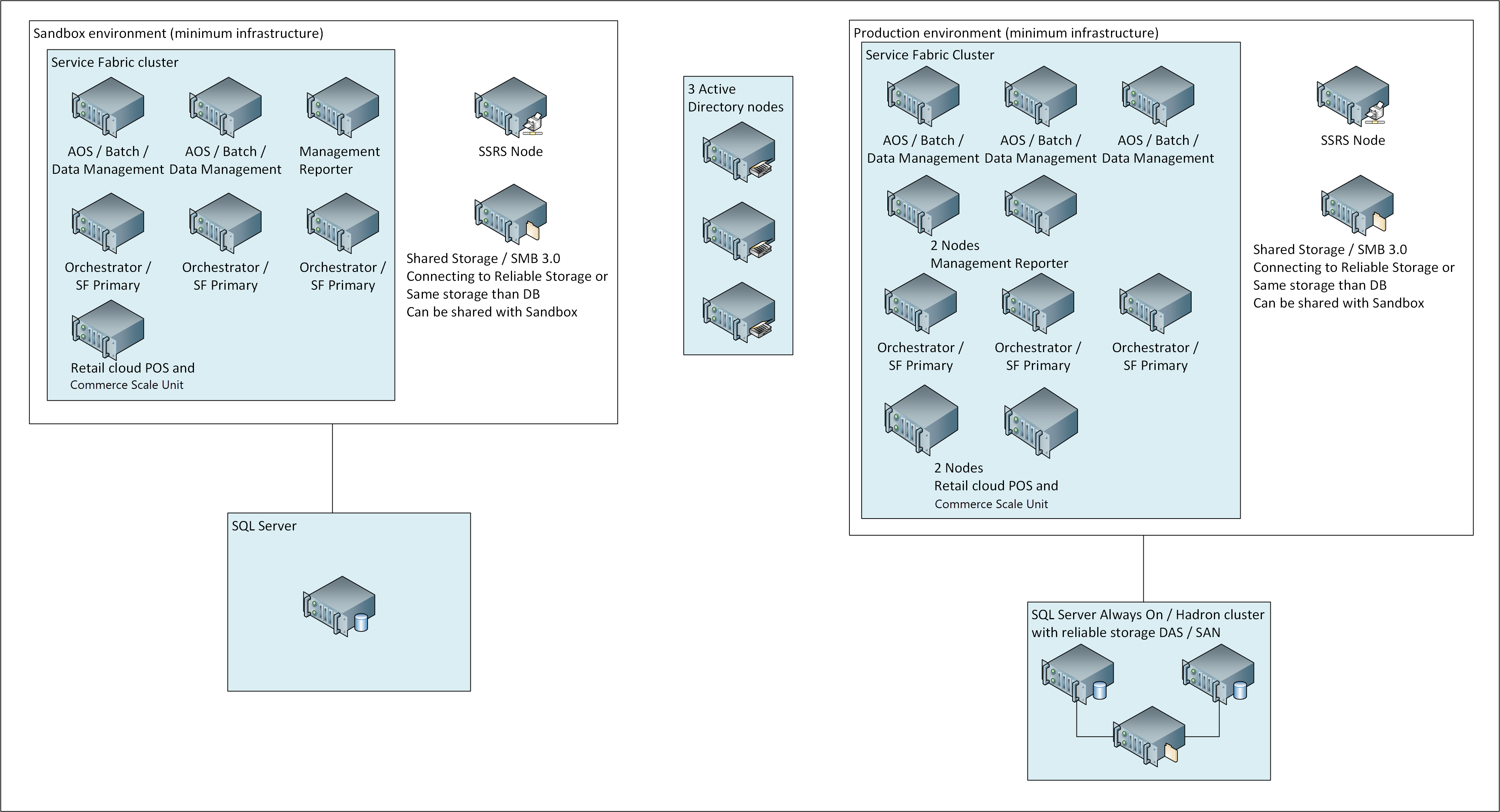События
Присоединение к вызову ИИ Навыков
8 апр., 15 - 28 мая, 07
Отточите свои навыки ИИ и введите подметки, чтобы выиграть бесплатный экзамен сертификации
Зарегистрируйтесь!Этот браузер больше не поддерживается.
Выполните обновление до Microsoft Edge, чтобы воспользоваться новейшими функциями, обновлениями для системы безопасности и технической поддержкой.
Примечание
Для доступа к этой странице требуется авторизация. Вы можете попробовать войти или изменить каталоги.
Для доступа к этой странице требуется авторизация. Вы можете попробовать изменить каталоги.
This article lists the system requirements for the current version of Microsoft Dynamics 365 Finance + Operations (on-premises) deployments. Verify that the system that you're working with meets or exceeds the minimum network, hardware, and software requirements.
Важно!
Dynamics 365 Finance + Operations (on-premises) is not supported on any public cloud infrastructure, including Microsoft Azure Cloud services. However, it is supported to run on Microsoft Azure Stack HCI and Microsoft Azure Stack Hub.
Dynamics 365 Finance + Operations (on-premises) can work on networks that use Internet Protocol Version 4 (IPv4) or Internet Protocol Version 6 (IPv6). Consider the network environment when you plan your system, and use the following guidelines.
The following table lists the minimum network requirements for the connection between the web browser and Application Object Server (AOS), and for the connection between AOS and the database in an on-premises system.
| Value | Web browser to AOS | AOS to database |
|---|---|---|
| Bandwidth | 50 kilobytes per second (KBps) per user | 100 megabytes per second (MBps) |
| Latency | Less than 250–300 milliseconds (ms) | Less than 1 ms (local area network [LAN] only). AOS and the database must be co-located. |
Deployments where AOS and the Microsoft SQL Server database are in different datacenters aren't supported. AOS and the SQL Server database must be co-located.
In general, Finance + Operations is optimized to reduce browser-to-server round trips. The number of round trips from a browser client to the datacenter is either zero or one for each user interaction, and the payload is compressed.
Предупреждение
Don't calculate bandwidth requirements from a client location by multiplying the number of users by the minimum bandwidth requirements. The concurrent usage of a given location is very difficult to calculate. We recommend that you use a real-life simulation against a non-production environment as the best gauge of performance for your specific case.
In LAN environments, Microsoft Remote Desktop in Microsoft Windows Server isn't required in order to connect to Finance + Operations. However, Remote Desktop might be required for servicing operations on the virtual machines (VMs) that make up the server deployments.
In wide area network (WAN) environments, Remote Desktop in Windows Server isn't required in order to connect to Finance + Operations.
Finance + Operations doesn't require internet connectivity from user workstations. However, some features won't be available if there is no internet connectivity.
| Browser client | An intranet scenario without internet connectivity is a design point for the on-premises deployment option. Some features that require cloud services won't be available, such as Help and Task guide libraries in Microsoft Dynamics Lifecycle Services (LCS). |
| Server | The orchestrator node types must be able to communicate with LCS for deployment and servicing operations. The on-premises browser-based client doesn't require internet access. |
| Telemetry | Telemetry data might be lost if there are long interruptions in connectivity. Interruptions in connectivity to LCS don't affect the on-premises application functionality. |
Most telemetry data is stored locally and can be accessed by using Event Viewer in Microsoft Windows. A small subset of telemetry events are transferred to the Microsoft telemetry pipeline in the cloud for diagnostics. Customer data and user-identifiable data aren't part of the telemetry data that is sent to Microsoft. VM names are sent to Microsoft to help with environment management and diagnostics from the LCS portal.
Consider the following domain requirements when you install Finance + Operations:
For compatibility with corporate domain controllers on Windows Server 2008 R2 domain functional level (DFL), a full 2-way trust between the Windows Server 2008 R2 DFL user domain and the Windows Server 2012 R2 DFL Finance + Operations service domain is supported.
This means that users of the Finance + Operations (on-premises) application will come from the Windows Server 2008 R2 DFL domain, and the resources and service accounts hosting the Finance + Operations (on-premises) infrastructure and services will come from the Windows Server 2012 R2 DFL domain.
Examples for a full 2-way trust setup could be.

This section describes the hardware that is required in order to run Finance + Operations.
The actual hardware requirements vary, based on the system configuration, the data composition, and the features that you decide to use. Here are some of the factors that can affect the choice of appropriate hardware:
Finance + Operations uses Service Fabric to host the AOS, Batch, Data management, SQL reporting, Management reporter, and Environment orchestrator services.
SQL Server must have a high-availability HADRON setup that has at least two nodes for production use.
The following illustration shows the minimum number of nodes that is recommended for your Service Fabric cluster.
[ ]
]
The following tables list the number of processors and the amount of random-access memory (RAM) that are required for each role that is required in order to run this deployment option. For more information, see the recommended minimum requirements for a Service Fabric standalone cluster in Plan and prepare your Service Fabric cluster.
Примечание
If other Microsoft software is installed on the same computer, the system must also comply with the hardware requirements for that software. If other server applications are installed on the same computer as AOS, we recommend that you limit those server applications 1 gigabyte (GB) of RAM.
Sizing by role and topology type
| Topology | Role (node type) | Recommended processor cores | Recommended memory (GB) |
|---|---|---|---|
| Production | AOS, Data management, Batch | 8 | 24 |
| SSIS | 4 | 16 | |
| Management Reporter | 4 | 16 | |
| SQL Server Reporting Services | 4 | 16 | |
| Orchestrator | 4 | 16 | |
| SQL Server | 8 | 32 | |
| Sandbox | AOS, Data management, Batch | 4 | 24 |
| SSIS | 4 | 16 | |
| Management Reporter | 4 | 16 | |
| SQL Server Reporting Services | 4 | 16 | |
| Orchestrator | 4 | 16 | |
| SQL Server | 8 | 32 |
Minimum sizing estimates for production and sandbox deployments
| Topology | Role | Number of instances |
|---|---|---|
| Production | AOS (Data management, Batch) | 3 |
| SSIS | 2 | |
| Management Reporter | 2 | |
| SQL Server Reporting Services | 1 | |
| Orchestrator** | 3 | |
| SQL Server | 2 | |
| Sandbox | AOS, Data management, Batch | 2 |
| SSIS | 1 | |
| Management Reporter | 1 | |
| SQL Server Reporting Services | 1 | |
| Orchestrator | 3 | |
| SQL Server | 1 | |
| Summary for production and sandbox topologies | 22 |
* The recommended hardware sizes are general guidelines only. Actual hardware requirements may vary based on specific customer processes, customizations, transaction volumes, and workloads. We strongly recommend that customers conduct thorough testing of any proposed configurations as part of a comprehensive performance evaluation exercise.
** Orchestrator is designated as the primary node type and will also be used to run the Service Fabric services.
Initial estimates for the back-end SQL Server and AD DS
| Role | VMs/instances | Cores | Total cores | Memory per instance (GB) | Total memory (GB) | |
|---|---|---|---|---|---|---|
| Shared infrastructure | SQL Server* | 2 | 8 | 16 | 32 | 64 |
| File server/Storage area network/Highly available storage | The back-end storage must be based on solid-state drives (SSDs) on a runtime storage area network (SAN).
Size and input/output operations per second (IOPS) throughput is based on the size of the workload. |
|||||
| Active Directory | 3 | 4 | 12 | 16 | 48 | |
| Summary for shared infrastructure | 5 | 28 | 112 | |||
* SQL Server sizes are highly dependent on workloads. For more information, see Hardware sizing requirements for on-premises environments. Separate SQL Server machines for sandbox and production environments must be used. However, SQL Server can be shared in all sandbox environments.
AOS & SSIS – Finance + Operations uses a Server Message Block (SMB) 3.0 share to store unstructured data. For more information, see Storage Spaces Direct in Windows Server 2016.
SQL – The following options are viable:
SQL Server and data management IOPS – The storage for both data management and SQL Server should have at least 2,000 IOPS. Production IOPS depends on many factors. For more information, see Hardware sizing requirements for on-premises environments.
VM IOPS – Each VM should have at least 100 write IOPS.
When you set up the virtual hosts for an environment, see the guidelines in Plan and prepare your Service Fabric cluster and Describing a service fabric cluster. Each virtual host should have enough cores for the infrastructure that is being sized. Multiple advanced configurations are possible, where SQL Server resides on physical hardware but everything else is virtualized. If SQL Server is virtualized, the disk subsystem should be a fast SAN or the equivalent. In all cases, make sure that the basic setup of the virtual host is highly available and redundant. In all cases, when virtualization is used, no VM snapshots should be taken.
Важно!
Do not use Dynamic Memory for your virtual hosts.
Finance + Operations falls under Microsoft's standard support policy regarding operation on non-Microsoft virtualization platforms – specifically VMWare. For more information, read Support policy for Microsoft software. In short, we support our products in this environment, but if we are asked to investigate an issue, we may ask the customer to first reproduce the problem without the virtualization platform or on the Microsoft virtualization platform.
The following software must be present on a computer before any Finance + Operations components can be installed:
For more information about Service Fabric, see Plan and prepare your Service Fabric cluster.
Примечание
For supported versions, see Microsoft Dynamics 365 Finance + Operations (on-premises) supported software.
For the hardware requirements for SQL Server, see Hardware and Software Requirements for Installing SQL Server. |
Users can access Finance + Operations by using the most recent versions of these popular browsers:
Примечание
For optimal performance and an optimal experience, we recommend that you use the latest version of a modern browser, especially Microsoft Edge.
Active Directory Federation Services (AD FS) on Windows Server is required.
The domain controller must be Windows Server 2012 R2 or later, and the domain functional level must be 2012 R2 or more. For more information about domain functional levels, see the following pages:
The following Microsoft Office applications are supported in on-premises deployments:
Currently, Finance + Operations doesn't include the Commerce components.
События
Присоединение к вызову ИИ Навыков
8 апр., 15 - 28 мая, 07
Отточите свои навыки ИИ и введите подметки, чтобы выиграть бесплатный экзамен сертификации
Зарегистрируйтесь!